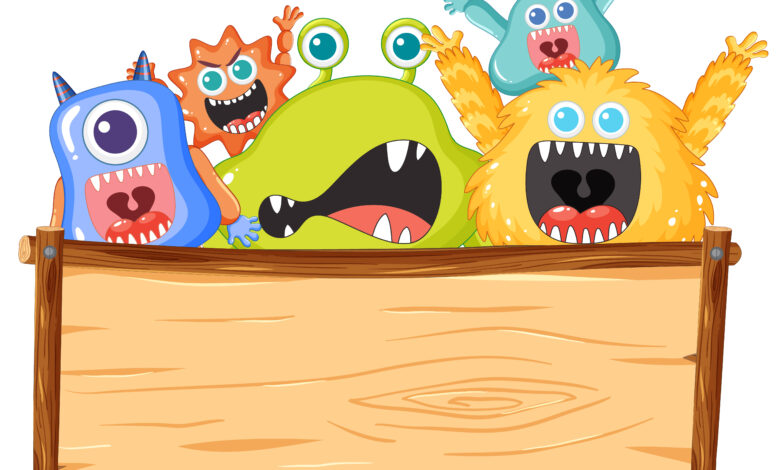Monster Names: Exploring Mythical Creatures Across Cultures

Monsters have been an integral part of human folklore and myth for centuries. These terrifying and fascinating creatures represent the unknown, often embodying humanity’s deepest fears and mysteries. Across different cultures and eras, monsters have taken on various forms, each with its unique traits and stories. From the malevolent beasts of ancient legends to the misunderstood creatures of modern fantasy, monster names have always held significant meaning. In this article, we will dive into some of the most iconic monster names from around the world, shedding light on their origins and the cultural significance they carry.
1. The Kraken: The Terror of the Sea
One of the most famous sea monsters in Norse and Scandinavian folklore is the Kraken. This giant squid-like creature is said to dwell off the coasts of Norway and Greenland, dragging entire ships to the depths of the ocean. The name “Kraken” comes from the Norwegian word for “crooked” or “twisted,” perfectly describing the giant tentacles that terrorized sailors for centuries. The Kraken is an embodiment of the fear of the unknown lurking in the deep, vast oceans, a place where few have ventured and even fewer have returned.
In modern times, the Kraken continues to be a popular figure in literature, films, and video games, symbolizing chaos and unstoppable force. Its name has become synonymous with massive, unstoppable challenges, reminding us of how the sea once posed a terrifying threat to early sailors.
2. Dracula: The King of Vampires
When it comes to monster names, few are as iconic as Dracula. Inspired by the real-life Romanian ruler Vlad the Impaler, Bram Stoker’s Count Dracula has become the most famous vampire in history. The name Dracula is derived from the Romanian word “Dracul,” meaning “dragon” or “devil,” a fitting title for a creature who feasts on the blood of the living.
Dracula is the archetype of the modern vampire, blending charm and horror in equal measure. His story has inspired countless adaptations and set the foundation for the entire vampire genre. The name itself invokes images of darkness, immortality, and a relentless hunger that makes Dracula one of the most feared and fascinating monsters in folklore.
3. Chupacabra: The Goat-Sucker of Latin America
Originating from Latin American folklore, the Chupacabra is a more recent addition to the pantheon of monster names. Its name translates to “goat-sucker,” as it is believed to prey on livestock, draining them of their blood. First reported in Puerto Rico in the 1990s, the Chupacabra has since become a symbol of rural mystery and terror across the Americas.
Unlike many monsters that are deeply rooted in ancient myths, the Chupacabra is a modern urban legend. Descriptions of the creature vary, but it is often depicted as a reptilian, alien-like being with spines along its back. Despite being a more contemporary monster, its name has quickly gained notoriety, especially among those living in areas where livestock predation remains a mystery.
4. The Wendigo: The Cannibal Spirit of the North
In Native American folklore, particularly among the Algonquin-speaking tribes, the Wendigo is a fearsome creature associated with famine, greed, and cannibalism. The name Wendigo has several interpretations, often linked to words meaning “evil spirit” or “cannibal.” The Wendigo is said to possess humans, turning them into monstrous beings with an insatiable hunger for human flesh.
The name Wendigo has become a symbol of unchecked greed and moral decay. As a spirit of hunger and winter, the Wendigo represents the dangers of losing one’s humanity in the face of desperation. In modern horror fiction, the Wendigo is often portrayed as a creature that preys on isolated individuals, pushing them to commit unspeakable acts to survive.
5. Medusa: The Gorgon of Greek Mythology
The name Medusa brings to mind one of the most chilling monsters in Greek mythology. Medusa, one of the three Gorgon sisters, is famous for her snake-covered head and the ability to turn anyone who looks at her into stone. Her name, derived from the Greek word “guardian,” contrasts with her terrifying nature as a deadly creature cursed by the gods.
Medusa’s tragic story, in which she is transformed from a beautiful maiden into a monster by the goddess Athena, adds layers of complexity to her character. Despite her monstrous form, Medusa has often been portrayed as a victim of circumstance, giving her a sympathetic edge in modern retellings. Her name, however, still strikes fear and represents the power of a gaze that can petrify anyone who dares approach.
6. The Yeti: The Abominable Snowman of the Himalayas
Known as the Yeti or “Abominable Snowman,” this creature is a prominent figure in Himalayan folklore. The name Yeti is derived from the Tibetan word “yeti,” which means “rock bear” or “cliff-dweller.” Described as a large, ape-like creature living in the snowy mountains, the Yeti is often considered a symbol of the untamed wilderness and the mysteries hidden within remote regions of the world.
The name Yeti has been popularized in Western culture through expeditions and sightings, although scientific evidence of its existence remains elusive. Despite this, the Yeti has earned its place among the most recognizable monster names, symbolizing the primal fear of what might be lurking in unexplored, icy terrains.
7. The Basilisk: The Serpent King of European Legends
In European folklore, the Basilisk is known as the “king of serpents,” with a name derived from the Greek word “basiliskos,” meaning “little king.” This monster is said to be able to kill with just a glance or its poisonous breath, making it one of the most dangerous creatures in medieval lore.
The Basilisk has been portrayed as both a giant serpent and a creature with a rooster’s head and snake-like body. Its name has become synonymous with lethal power and toxic danger, reinforcing its status as a monster to be feared in both ancient and modern tales.
See Also Read: Monster Names.
Conclusion
Monster names carry with them the weight of centuries of fear, fascination, and cultural symbolism. Whether they originate from ancient myth or modern legend, these names evoke the mysteries and terrors that have haunted humanity throughout history. From the deep-sea Kraken to the bloodthirsty Dracula, each monster reflects a unique aspect of human imagination and the unknown. As we continue to explore these creatures in literature, film, and art, their names will remain deeply etched in our collective consciousness, reminding us of the powerful role monsters play in our stories and fears.





